The materials for average epoxy repairs are simple—common hand tools and containers of A and B fillers—but they can solve problems throughout the exterior and interior surfaces of an old house.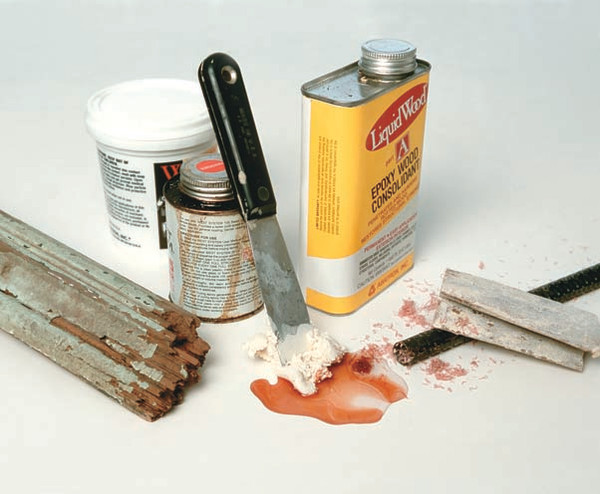
Many of the techniques that form the core of historic preservation are actually traditional tools, methods, and materials developed over centuries for the maintenance and repair of existing buildings, but not all of them. The modern restoration movement also makes active use of the full arsenal of modern building technology, such as power tools for cutting stone, or lasers and computer software for analyzing problems. This includes the use of man-made materials and compounds, and one of the most versatile and effective materials in this arsenal is epoxy technology.
Epoxies have continued to grow in their popularity and versatility over the last three decades, but many old-house restorers are still not clear about all these materials can do—and perhaps just as important, what they cannot do. It doesn’t help that there are many epoxy products on the market, each engineered to operate in an individual way and often for specific uses or kinds of projects. To help with understanding this still-growing methodology, we have put together the following primer to help explain the common applications and general use of epoxies in old-house restoration as a guide for understanding what’s possible for matching products and projects.
The A and B components of fillers are usually different colors to help with proper proportioning and thorough mixing—critical for complete curing of the epoxy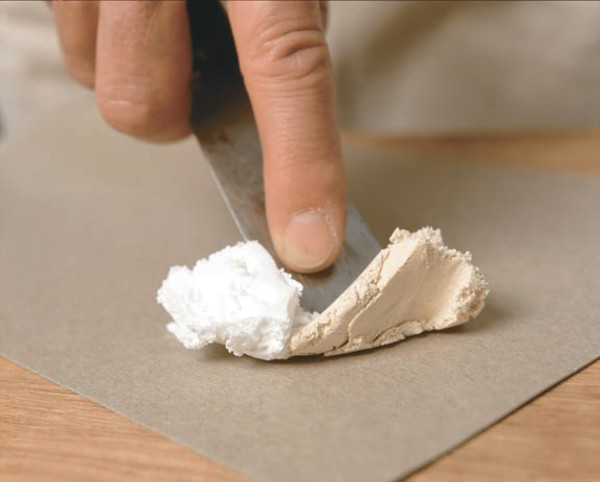
What is Epoxy?
Epoxy first became a household word in the 1960s, when a new breed of super-strong adhesives started to appear in local hardware stores. Its extensive use dates back as far as the 1940s. Like plywood, Plexiglas, and many other innovations that later became construction materials, epoxy technology was perfected during World War II, in this case as an alternative to metal fasteners for joining members in aircraft production. Briefly, epoxies are petroleum-based resins that cure to a solid state when combined with the right amount of the appropriate hardener. Epoxies are two-part systems—typically cans or tubes labeled A and B—that must always be mixed immediately before application. In contrast, a one-part system like yellow carpenters’ glue is usable right out of the bottle at any time.
Epoxies are also thermosetting—that is, they create heat as they cure. This is important to remember because substantial quantities of mixed resin and hardener—excess left in a mixing container, for example, or a pouring 1″ or more thick—can generate enough heat to melt the container or burn the epoxy. For the same reason, resin that is warm or used in a warm environment will cure at an accelerated rate. (Direct sunlight also will speed up the curing reaction.) The good news is temperature can be used to improve the working properties of the epoxy during adverse conditions, by cooling the resin in an ice bath on hot days to increase the pot life, or circulating warm air around a project in cold weather.
Consolidant effectively saturates the deteriorated wood of thin object, such as window sashes, with repeated brushings that pay particular attention to end grain. Large projects often require small holes for deeper penetration.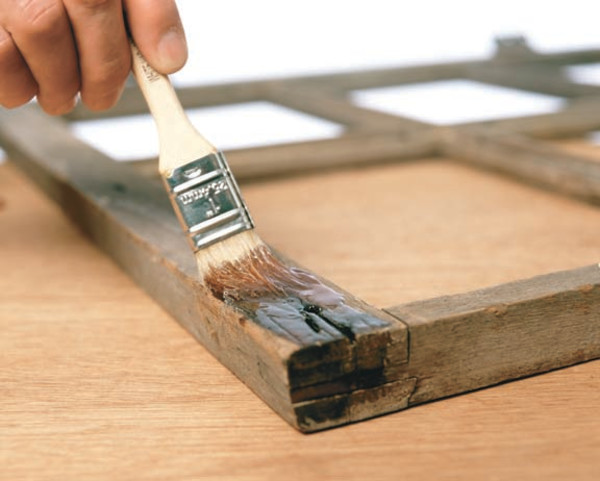
Consolidants and Fillers
Epoxies have really come into their own in restoration work for the repair and reconstruction of wood building parts. Where the component still retains its general shape, but has lost much of its integrity due to rot, fungal growth, or insect damage, epoxy consolidants can be used to reinforce the remaining wood fiber. Generally speaking, the consolidant is resin that has been formulated for low-viscosity so that porous wood readily absorbs it like a sponge. Ideally, the consolidant penetrates right to the threshold of sound wood, returning the damaged area to a significant percentage of its former strength and consistency when it cures. In small projects, resin and hardener mix is often simply brushed repeatedly onto the component surface as the wood drinks it up. Larger projects often require perforating all of the damaged wood with small holes in strategic spots to enhance saturation, then filling these holes with consolidant mixture from a squeeze bottle. (Consult the manufacturers’ recommendations for instructions.)
The typical consolidation candidates in old houses are the rotted parts of window sash, doors, and carved or molded features, such as newel posts and column details. Indeed, the beauty of consolidants from a practical (as well as historic preservation) standpoint is that they retain as much as possible of the original wood. Moreover, they can often be used without removing the building part from its installed position. Epoxy consolidants, however, are for the most part not reversible; once they have cured they cannot be undone with, say, a special solvent. Consolidants help restore the integrity of wood, but it takes epoxy fillers to replace lost wood fiber.
These materials are resins and additives combined (often in proprietary mixtures) to make a gap-filling paste. Unlike simple one-part wood putty, epoxy fillers are, again, mixed from A and B components and often formulated not only to adhere well to consolidated wood (which helps increase their bond in tough, outdoor conditions) but flex like wood and even tool like wood with planes, chisels, and sandpaper. Autobody fillers and resins, which appear to be similar, are not wood restoration epoxies. Generally, these are polyester resins that cure with the addition of a catalyst. They are not formulated for absorption by wood. The fillers in particular are engineered to adhere to and move with sheet metal, and therefore they may not stay in place on, say, a wood window sill. Epoxy fillers are ideal for filling the voids and holes in wood: checks and splits from weathering; holes from old hardware, countersunk screws and nails; lost knots and woodpecker holes.
Epoxy fillers bond best to wood that was previously consolidated and cured. Note how the weathered wood has completely absorbed the low-viscosity consolidant applied earlier.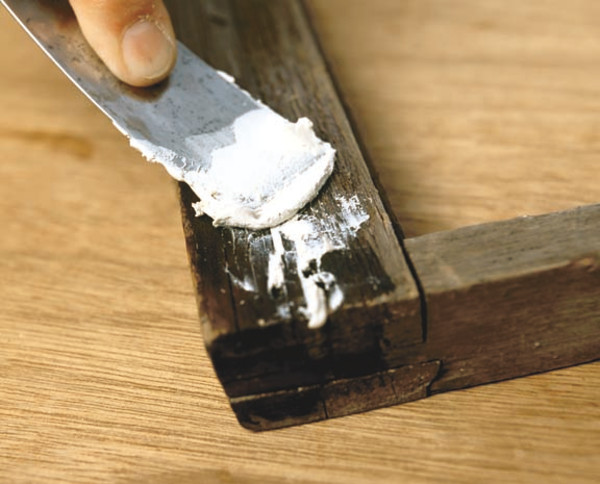
However, the right fillers can also be used to reconstruct totally lost features by building up the filler in several stages, then sculpting or forming it with woodworking tools. The epoxy curing process actually has three stages, and this can be a great advantage when working with fillers. When the liquid resin or paste filler is first mixed with hardener, it remains in an easily manipulated first stage called the open time or working time. Before the epoxy cures to the third solid stage, it passes through a second stage, often called the gel or kick-off stage. In this short stage, the epoxy has begun its initial cure; while it is no longer a liquid it is not quite yet a hard solid. When fillers reach this soft, rubbery stage, the time is ideal to rough out general shapes and remove large amounts of material by quickly sculpting them with “cheese grater” tools (such as Stanley Surform planes). With experience, it’s possible to quickly work the filler without breaking its bond to the wood, waiting until the filler has cured hard for final shaping and sanding.
Important Considerations for Epoxy
Consolidants and fillers are very versatile and user-friendly, but they still require proper preparation and evaluation of their appropriateness before moving ahead with a project.
Moisture: The root of all building problems, moisture is a critical issue with epoxies. Wood damaged by rot or fungal growth needs to have 1) the source of moisture corrected and 2) the wood thoroughly dried through air circulation or heaters. Epoxies cannot penetrate wood fiber that already has a high moisture content such as might be found in the inner sections of a post or column. Moreover, if the consolidant is applied so that it cures on only the dry outer surface of such a member, it will trap the moisture inside the wood where it will continue to promote damage. For this reason, some restoration conservators use consolidants in conjunction with wood preservatives, such as borates, when working on large repairs.
When cured, epoxy fillers formulated for wood restoration can be shaped and sanded the same as hardwoods.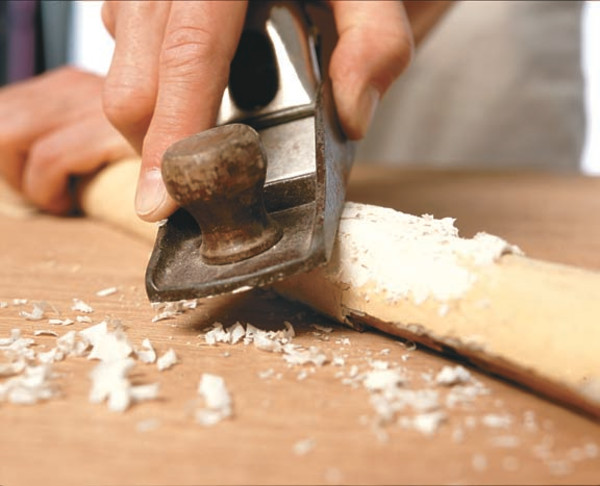
Appearance: If the epoxy repair is in, say, a floor that is due to have a clear varnish, its visual impact is worth noting. Epoxy products made for wood restoration are generally formulated with clear or amber resins and wood-toned fillers. Nonetheless consolidants, like any adhesive, can slightly alter the tone of wood, and fillers do not generally take stain the same as wood.
Cost vs. Value: Volume for volume, epoxy fillers and consolidants are more expensive than most woods, so the value—both economically and philosophically—of making repairs with epoxy versus new wood has to be considered. That is not to say that repairs cannot be a hybrid of epoxies and patches of new wood, but the time and expense of a large epoxy repair on a common, mundane building component—a simple porch railing, for instance—may be better spent on a feature that would be much more difficult or costly to replace in-kind, like a carved column capital.
Safety: Like any active compounds, epoxies should be used with proper care and respect by following the manufacturer’s instructions. Wear gloves and eye protection and avoid getting liquid materials, especially hardeners, on skin. Work with good ventilation.
Epoxy technology has proved so effective for the repair and reconstruction of wood building parts that over the last decade the methods and products have expanded to a wider range of building materials. With concrete now in its second century of wide use, epoxy products are increasingly turned to the repair and construction of features built with this material. Epoxy repair techniques for the repair of load-bearing members, such as heavy timber beams, have grown steadily since experiments in the 1970s. As epoxy technology continues to extend its track record and grow in applications, we are bound to see more.







